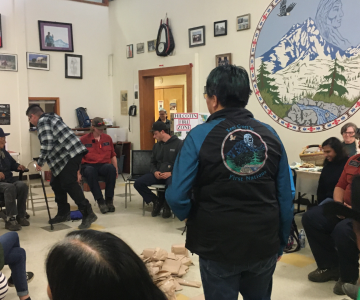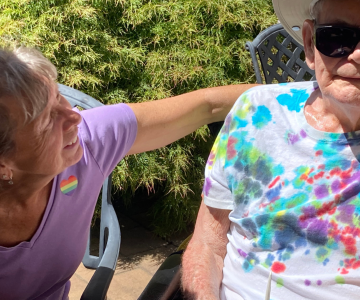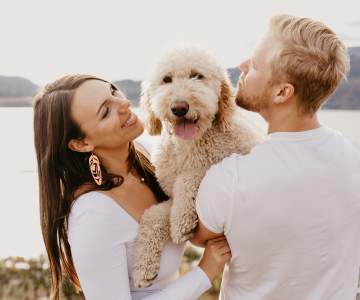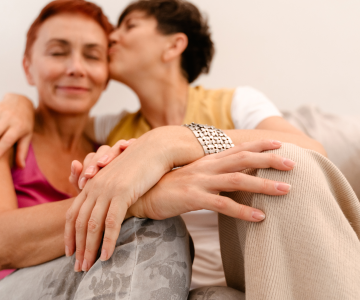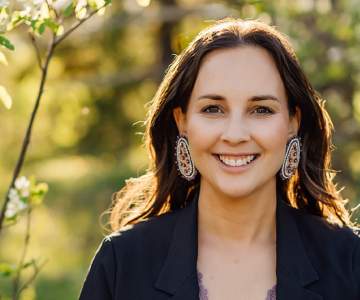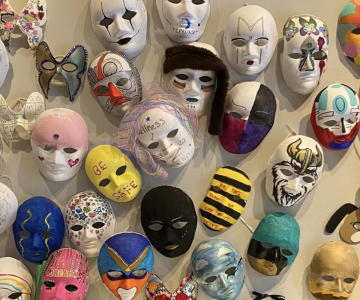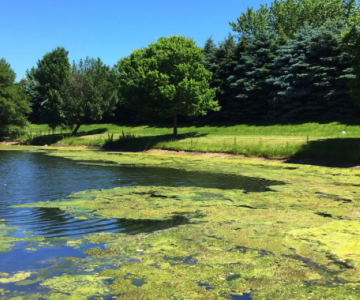Breadcrumb
Explore Stories
7 Minute Read
Health & Wellness
Climate change is a global issue affecting social, economic and environmental factors that determine our health: clean air, safe drinking water, secure and safe places to live, and income and livelihood. Climate change is also strongly linked to health inequities: communities and populations that are most vulnerable to the impacts of climate change are often those that contribute least to the problem.
First Nation communities are uniquely affected by climate change due to colonial systems, such as the imposed land reserve system. The reserve system fragmented large traditional territories into small parcels of land that were often established in areas that were not desirable to colonial governments, such as on floodplains or in areas downstream from major industrial developments.
2 Minute Read
Community & Culture
Darcy Jong became a dedicated 2SLGBTQIA+ ally after attending an education workshop identifying common fears elders may experience when being placed into long-term care homes and belong to the 2SLGBTQIA+ Rainbow Community.
In her role as a recreation therapist at David Lloyd Jones long-term care home, Darcy is responsible for completing assessments that gather valuable information about elders, including their past and present hobbies and interests, community supports, passions and culture. Gathering this information and working collaboratively with the elder guides her decision-making in creating their care plans. Care plans support the individual’s holistic needs and empower them to live and experience the best quality of life possible in a long-term care setting.
"I can’t recall the actual number of recreation assessments I have completed since my career began in 1991," says Darcy. "I can recall, however, the very small number of elders who felt comfortable sharing with me that they were part of the Rainbow Community. Knowing an elder’s true self allows us to honour, support and care for them the best way we can."
3 Minute Read
Health & Wellness
Ann was in the grocery store when she could feel a sneeze coming on. “I thought, ‘Oh no. I’m going to have an accident right here in the store.’ My bladder was somewhat full, and all I could do was cross my legs.”
In her early 50s and post-menopause, the Penticton mom of four had been experiencing leaks when sneezing for some time. “I was a bit frustrated because even though I understand why I’m more prone to urine incontinence, I’m also healthy and fit, and have a strong core.”
While going to her doctor was her first choice, she also discovered Penticton is home to a pelvic health physiotherapy clinic. She booked an appointment with Sofy Tsai, a registered physiotherapist specializing in pelvic health at Interior Health and in private practice.
After seeing Sofy, Ann kept a bladder and bowel journal for a couple weeks. At her follow-up visit, Sofy was able to determine Ann didn’t have a prolapsed or overactive bladder – common reasons for urine incontinence. She also had good pelvic muscle tone.
Sofy not only taught Ann several exercises to strengthen and relax her pelvic floor, but a couple of tricks to do if she felt a sneeze coming on. She also gave Ann several take-home resources and exercises she could do on her own time. “The sneezing trick alone was a lifesaver,” laughs Ann.
“Our pelvic floor muscles are just like any other muscle in our body and can be trained,” says Sofy. “Having incontinence does not always mean you need to do Kegels. Sometimes your pelvic floor may be too tight, so strengthening it is not going to stop you from leaking. A proper evaluation by a pelvic health physiotherapist or health-care practitioner can help evaluate the root cause of your symptoms, and help you learn to regain control and confidence in your bladder and bowel function.”
3 Minute Read
Community & Culture
Name: Nicole Taylor-Sterritt (she/her)Job Title: Lead, Indigenous EngagementYears of Service: 2Worksite: Kelowna CHSCCommunity: Syilx (Okanagan) territoryAncestral Territory: Syilx NationFavourite Quote / Advice to live by: "Do all things with love."
Born and raised in the Musqueam, Squamish and Tsleil Waututh territory, what’s known as Vancouver, B.C., and now residing in the unceded Syilx territory in Kelowna, Nicole Taylor-Sterritt is of mixed heritage and a proud member of the Kispiox Band of the Gitxsan Nation.
Nicole loves to be around people and is the kind of person who invites everyone over to gather at the end of the day to hang out. On two separate occasions, her cousin and an Elder told her that she is "the one who brings people together" – a title she embraces with pride; so much so, from 2016-2021 she worked as an event planner.
In 2018, Nicole and her mom co-founded the Indigenous Women's Leadership Summit, which opened her up to a world where she could work to better the lives of her Indigenous community, and in a roundabout way led her to her job now at Interior Health (IH)!
3 Minute Read
Health & Wellness
There's always potential for extended hot temperatures in the summer. Here's what you can do to ensure you and your family remain safe and healthy this summer.
5 Minute Read
Health & Wellness
If you chat with someone in their 60s, 70s, 80s—and beyond—it can be like meeting a human book. Every person has a remarkable story to tell, and a lifetime of experiences, joys and heartaches, triumphs and traumas.
Now consider if you met a senior or older adult from the 2SLGBTQIA+ (Two-Spirit, lesbian, gay, bisexual, transgender, queer/questioning, intersex and asexual +) community. Someone who was born in 1949, and is now 75 years old, would have witnessed or experienced these events:
In 1969, homosexual acts are partially decriminalized in Canada (when they were 20 years old)
Homosexuality is removed from the DSM (Diagnostic and Statistical Manual of Mental Orders) in 1973 (when they were 24)
In 1990, the World Health Organization (WHO) removes homosexuality from the list of mental disorders (when they were 41)
In 1996, the Canadian Government adds sexual orientation to the Charter of Rights and Freedoms (when they were 46)
In 2005, same-sex couples have the right to marry in Canada (when they were 56)
In 2019, the WHO removes transgender from the list of mental disorders (when they were 70).
This timeline is from “Bridging Generations: Inclusive Care for all 2SLGBTQIA+ Ages” by Lisa Salazar.
The Fruit Machine | TVO Original Documentary (youtube.com)
2 Minute Read
Community & Culture
Name: Kelsey Arnouse, Registered Social Worker (RSW) (she/her/hers)Job Title: Indigenous Cultural Safety EducatorYears of Service: 8Worksite: Sahali Mall, KamloopsCommunity: Tk’emlúps te Secwépemc Ancestral Territory: Secwépemc NationFavourite Quote / Advice to live by: “It’s education (that) got us into this mess, and education (is what) will get us out of it.” - Justice Murray Sinclair
Born in the traditional, unceded Stó꞉lō Nation territory and raised on the traditional, ancestral and unceded territory of her Secwépemc Nation, Kelsey Arnouse is a proud community member of Tk’emlúps te Secwépemc.
Kelsey's maternal family is from Tk’emlúps te Secwépemc and her paternal family is from Sexqeltqin; both communities are within the Secwépemc Nation. She also acknowledges her roots as a third-generation Irish settler.
5 Minute Read
Community & Culture
In the eight years since B.C. declared a public health emergency because of deaths due to unregulated drug poisonings, more than 14,000 people have died in our province.
In our ongoing Stories@IH series, we share voices from the toxic drug crisis. In this story, meet Cheryl, a peer volunteer from Vernon who has found hope and purpose in helping others who use drugs.
3 Minute Read
Health & Wellness
Algae are a natural part of our water ecosystems in the Interior Health region.
Blue-green algae are also found in our ecosystems like lakes. But unlike its name implies, blue-green algae are actually a microscopic bacteria called cyanobacteria.
Cyanobacteria can live in waters through winter. In the warmer spring and summer months, cyanobacteria can multiply very quickly and produce several types of toxins that can be poisonous to people, pets and livestock.
“It’s that time of year when we can see increased blue-green algae (cyanobacteria) blooms on lakes. These blooms tend to stay on the water surface and may have a leafy scent,” says Interior Health chief deputy medical health officer Dr. Silvina Mema. “Sometimes blooms can be toxic for those who come in contact with the water. My advice is to use common sense and avoid contact or consuming water if you suspect there is a cyanobacteria bloom.”
-
Load More
Showing 72 of 677
STAY CONNECTED
Receive news and alert posts, and Stories@IH blog posts, right to your inbox!

